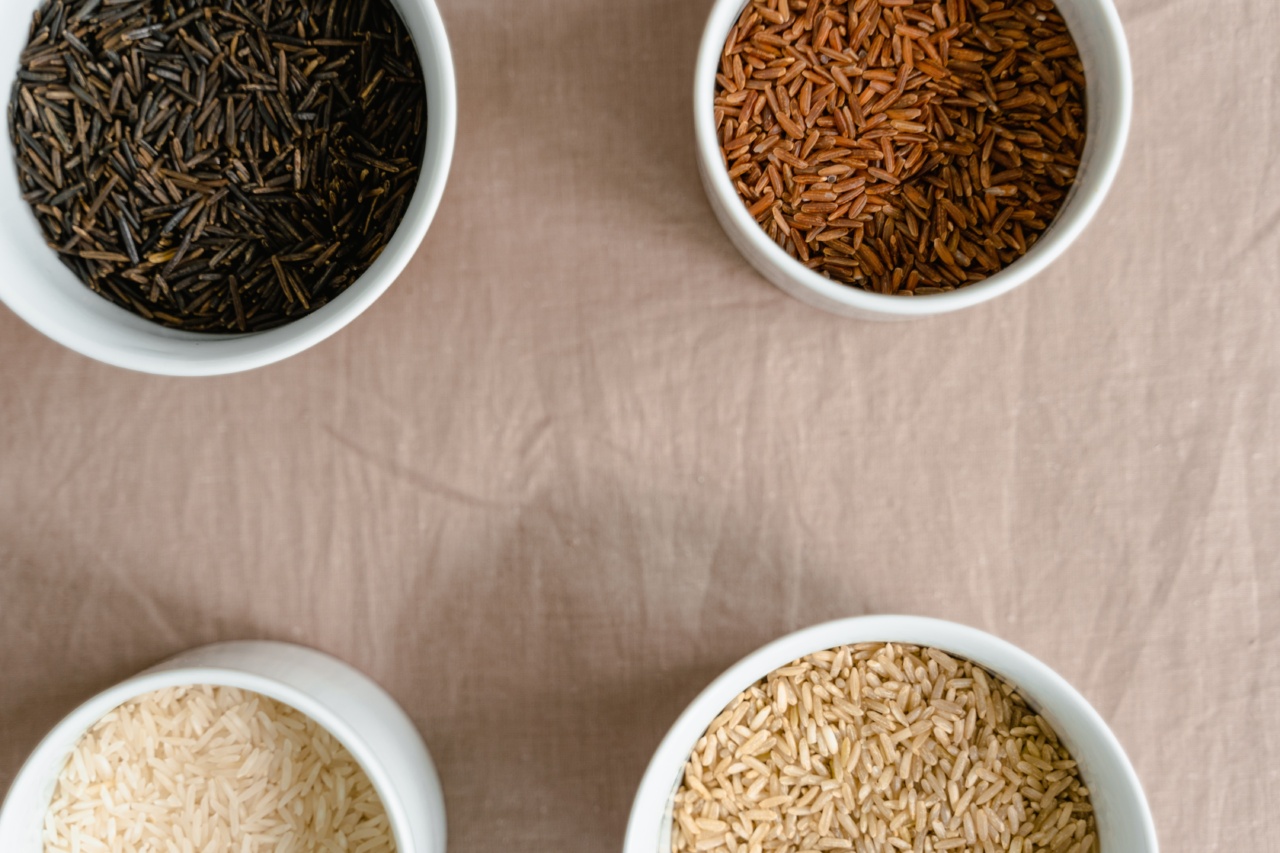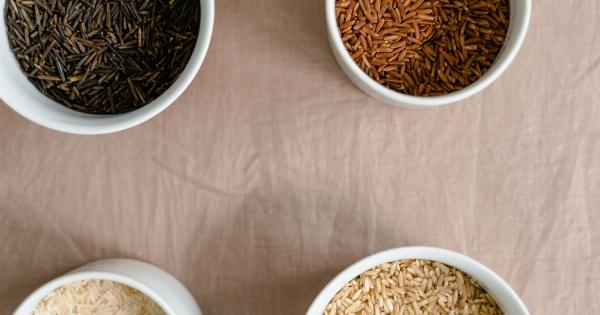When it comes to grains, rice is a staple in many cuisines around the world. There are various types of rice available, but two of the most commonly consumed varieties are white rice and brown rice.
White rice is the refined version of brown rice, which means that the bran and germ layers have been removed, leaving only the innermost layer, the endosperm. Brown rice, on the other hand, is the whole grain version, where the bran and germ layers are retained. This leads to a significant difference in their nutritional profiles.
In this article, we will delve into the battle between white and brown rice to determine which one is more nutritious.
1. Nutritional Comparison
Before we delve into the specifics, it’s important to understand what makes a grain nutritious. Nutritional value is determined by the presence and quantity of various vitamins, minerals, fiber, and other beneficial compounds.
Let’s compare the nutritional profiles of white rice and brown rice:.
a) Calories: When it comes to calorie content, both white and brown rice offer similar amounts. In 1 cup of cooked rice, white rice contains approximately 242 calories, while brown rice contains around 218 calories.
So, if you are trying to manage your calorie intake, there is not much difference between the two.
b) Carbohydrates: Rice is primarily a source of carbohydrates, providing energy to fuel our bodies. White rice is more processed and has a higher glycemic index compared to brown rice.
This means that white rice is digested and absorbed more quickly, leading to a rapid spike in blood sugar levels. Brown rice contains complex carbohydrates and has a lower glycemic index, resulting in a slower and more sustained release of energy.
Therefore, brown rice is generally considered a better option for those looking to control blood sugar levels and manage weight.
c) Fiber: The refining process that produces white rice strips away the fiber-rich bran layer, significantly reducing its fiber content.
Brown rice, being the whole grain, retains its bran layer and therefore is a great source of dietary fiber. In fact, a cup of cooked brown rice contains about 3.5 grams of fiber, while the same amount of white rice only provides around 0.6 grams.
Fiber is essential for a healthy digestive system, promoting regular bowel movements and aiding in weight management.
d) Vitamins and Minerals: Brown rice is a winner when it comes to vitamins and minerals.
It contains higher levels of various B vitamins like thiamin, niacin, and vitamin B6, which play a crucial role in energy production, brain function, and red blood cell formation. Brown rice also provides more magnesium, phosphorus, and potassium compared to white rice. These minerals are essential for bone health, nerve function, and maintaining proper fluid balance in the body.
White rice, on the other hand, is often fortified with nutrients like iron and folic acid to make up for the loss during processing.
e) Antioxidants: While both white and brown rice contain some antioxidants, the levels are higher in brown rice due to the presence of the bran layer.
Antioxidants help protect our cells from damage caused by harmful free radicals and have been linked to a reduced risk of chronic diseases, such as heart disease and certain types of cancer.
2. Glycemic Index and Blood Sugar Control
As mentioned earlier, brown rice has a lower glycemic index compared to white rice. The glycemic index (GI) is a measure of how quickly a carbohydrate-containing food raises blood sugar levels.
Foods with a high GI are rapidly digested and can cause a sharp increase in blood sugar, which is then followed by a crash in energy levels. On the other hand, low GI foods are digested more slowly, leading to a more gradual release of sugar into the bloodstream.
For individuals with diabetes or those trying to maintain stable blood sugar levels, choosing low GI foods can be beneficial. Brown rice has a GI of around 50, while white rice has a GI ranging from 70-73.
This significant difference is attributed to the presence of fiber and other nutrients in the bran layer of brown rice, which slow down the digestion and absorption of carbohydrates.
Incorporating brown rice into your diet can help stabilize blood sugar levels, promote satiety, and reduce the risk of developing type 2 diabetes.
It is worth noting that combining rice with protein-rich foods or healthy fats, like lean meats or avocado, can further lower its overall glycemic impact.
3. Weight Management and Satiety
Fiber plays a crucial role in weight management and promoting feelings of fullness or satiety after a meal. As mentioned earlier, brown rice contains significantly more fiber than its white counterpart, making it a more filling option.
The extra fiber slows down digestion, prolongs the feeling of fullness, and prevents overeating.
Additionally, the lower glycemic index of brown rice also aids in weight management. When we consume high GI foods, there is a rapid spike in blood sugar levels, followed by a subsequent drop.
This roller coaster effect often leads to increased hunger and cravings for more carbohydrates or sugary foods. By choosing low GI foods like brown rice, we can avoid these blood sugar fluctuations, ultimately helping to regulate appetite and control weight.
It’s worth noting that portion control still plays a significant role in weight management. While brown rice may be healthier than white rice, consuming excessive amounts can still contribute to weight gain.
Balancing portion sizes and incorporating a variety of nutrient-dense foods is key to maintaining a healthy weight.
4. Digestive Health
Dietary fiber, as found in brown rice, is essential for maintaining a healthy digestive system. It adds bulk to the stool, promotes regular bowel movements, and helps prevent constipation.
Adequate fiber intake has also been linked to a reduced risk of developing digestive disorders, such as diverticulosis and hemorrhoids.
Additionally, the fiber in brown rice acts as a prebiotic, providing nourishment for the beneficial bacteria in our gut.
These probiotics play a crucial role in maintaining a healthy gut microbiome, which is linked to numerous aspects of overall health, including immune function and mental well-being.
On the other hand, the low fiber content in white rice may lead to slower digestion and potential digestive issues for those who consume it in excess or have underlying digestive conditions.
5. Conclusion: The Verdict on White and Brown Rice
When it comes to nutritional value, brown rice takes the lead over white rice. It contains more fiber, vitamins, minerals, and antioxidants. The high fiber content aids in digestion, weight management, and blood sugar control.
The lower glycemic index of brown rice makes it a preferable option for individuals with diabetes or those looking to stabilize their blood sugar levels.
However, this doesn’t imply that white rice should be entirely eliminated from one’s diet.
White rice can still be consumed in moderation and be a part of a well-balanced diet, especially if it is fortified to restore some of the lost nutrients during processing.
It’s important to consider personal health goals, cultural preferences, and individual dietary needs when deciding between white and brown rice.
Opting for a variety of whole grains, including brown rice, quinoa, barley, and others, can provide a wider range of nutrients and enhance overall health.































